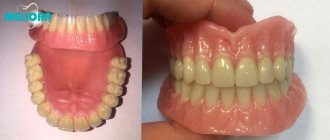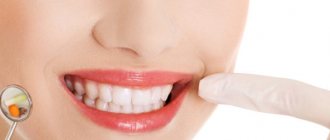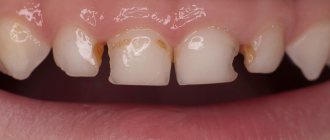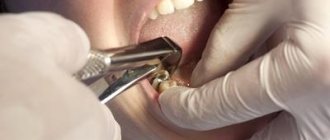Dental restoration methods
Stages of dental restoration
Cost of dental restoration
Alternative options
Video of dental restoration
Photos of dental restoration
Restoration of damaged teeth is a procedure necessary to restore normal chewing function and obtain an aesthetic effect. Restoration is performed by using filling materials or veneers. Artistic restoration (synonyms: cosmetic or aesthetic) is intended to improve the appearance of the dentition.
Basic methods of teeth extension and restoration
- Composite building - the main characteristics and advantages of the method of restoration with such material
For this type of extension, composite filling materials are used. These multi-component compositions allow you to reliably and quickly remove the defect, restoring a beautiful row of teeth. The material is exposed to ultraviolet rays, causing the base to harden. The average lifespan of a tooth augmented with this material is up to 10 years. Over time, the filling loses its strength and aesthetic characteristics, and therefore it is recommended to repeat the extension.
Advantages of composite fillings when building:
- a fairly reliable filling for a tooth, but slightly inferior to a photopolymer;
- service life after this method of extension is up to five years;
- affordable treatment - cheaper than photopolymer.
- Photopolymer extension – features and advantages of the restoration method
- impeccable aesthetics;
- the reliability of the photopolymer is higher than that of composites;
- a variety of complexity groups, which allows you to close almost any defects;
- service life after extension – up to ten years;
- The photopolymer hardens quickly. Restoring the structure in this way is very comfortable for the doctor.
Teeth augmentation with photopolymer (dental light polymer) is a method of restoring the integrity of a tooth using a light-curing material. A photopolymer (monomer or low molecular weight monomer) hardens when exposed to light.
Advantages of photopolymer fillings for tooth extension:
What is the difference between the method of tooth augmentation with composites and photopolymer restoration? Composite means a combination of substances, that is, several chemical components are mixed to form a filling, and a “chemical multi-component filling” is obtained. Composites are used to restore the back of the tooth, and photopolymers are used for the front zone of the smile, which is why the latter materials are an order of magnitude more expensive than composites.
A veneer is a thin plate that sits on a tooth using a special glue. The main goal of a dental procedure is to give teeth a flawless appearance in terms of color, shape and clarity. The method of building up teeth with such onlays is more of an aesthetic restoration. Veneers, as a rule, are placed on the smile zone (front 8 - 10 units) of the upper jaw, and the lower teeth (if they are healthy) are whitened to the shade of the plates themselves.
Advantages of veneers for tooth extension and restoration:
- impeccable appearance;
- speed of manipulation;
- the ability to use extensions to correct a slight curvature of the tooth;
- plates can cover chips, microcracks, yellowish or brownish stains on teeth, thinning enamel;
- veneers correct the presence of gaps between teeth;
- the linings retain their shape, color, and transparency throughout their entire service life.
Depending on the installation method, there are the following types of veneers for teeth extension:
- ceramic – ready-made plates that are pre-fabricated in a dental laboratory. They are considered more reliable than composite ones, but at the same time they are several times more expensive;
- composite - the same composite fillings that are built up by an esthetician dentist directly in the patient’s oral cavity.
The main nuance of installing ceramic plates is the need to grind down healthy tooth enamel before the extension. And this process is irreversible, i.e., if you want to refuse veneers in the future, they will be removed, but the tooth will be without the top layer.
Installing a ceramic veneer does not mean that it will last the patient’s entire life after the extension. Firstly, dental veneers are quite fragile and can break or fall off, especially when eating hard foods. Secondly, over time, even the highest quality ceramic veneers need to be replaced, because... their service life is up to twelve years.
The method of building up with crowns can be called full-fledged prosthetics. It helps when the patient has lost most of a tooth, or has no tooth at all. Ceramic crowns are suitable for both the restoration of front and back teeth. And this is the optimal solution when the amount of tooth destruction is up to seventy percent, and it urgently needs to be increased. To build up a damaged tooth, the dentist grinds it down and makes an impression, according to which an individual ceramic crown is made in a dental laboratory. After this, the crown is tried on, and if the result is positive, it is “set” on dental cement.
Types of dental crowns:
- from metal ceramics;
- ceramic crowns.
Advantages of ceramic crowns for teeth:
- versatility;
- good aesthetics;
- affordable price.
When installing even the highest quality ceramic crowns, no one is safe from their accidental loss. This is especially true for building up front teeth. It’s one thing to build it up, and another thing to take care of your smile so as not to spoil all the beauty!
Features of the method
All-on-4 is a technology of simultaneous implantation and dental prosthetics, when the patient is implanted with only 4 implants, on which a conditionally removable denture is fixed. Fastening the prosthesis with screws allows the dentist to quickly and easily remove it (this may be necessary, for example, for its correction).
Indications:
- Complete absence of teeth on one or both jaws.
- Bone atrophy.
- Contraindications to traditional two-stage technology.
- Periodontal diseases.
- The previously installed bridge and crowns are worn out
Restrictions and contraindications:
- Malignant neoplasms.
- Diabetes.
- Kidney, liver and heart failure.
- Blood diseases.
- Extreme bone atrophy in the upper jaw.
- Temporary restrictions: inflammatory diseases of the nasal sinuses and infections of the oral cavity.
Which extension method should I choose for chewing teeth?
The dentist always depends on whether the damaged chewing tooth has a nerve. In the absence of a nerve, it is better to restore it in this way: “fiberglass pin + composite tooth filling” or “tooth stump inlay + ceramic crown.”
If the chewing tooth has a healthy nerve, the crown part can be built up with a classic filling made of composite material, and for strength, a special inlay made of light-cured glass ionomer can be installed.
What to do before visiting a doctor?
What to do if a piece of a tooth breaks off? First of all, make an appointment with a dentist.
But until you see a specialist, you can take some measures to get rid of the pain and consequences. These include:
- rinsing the mouth with warm water or a weak saline solution. This will remove food particles and the actual tissue of chipped enamel from the oral cavity. If a doctor’s appointment is not scheduled for the near future, it is better to repeat rinsing 2-3 times a day;
- You should not avoid hygiene procedures - it is important to brush your teeth, being careful at the site of damage;
- if the damage is serious, save the broken piece: with its help, the doctor will be able to easily restore the shape of the crown;
- taking painkillers - give preference to an analgesic that has already been taken before and to which there are no allergic reactions. But you shouldn’t get carried away with it, take the recommended dose and go to the clinic;
- if the sharp edges of the chip damage the mucous membranes, try to disinfect them - rinse your mouth with an antiseptic solution;
- If tooth mobility is observed due to severe damage, try to fix it in the correct position by clenching the jaws. You should not be zealous, it is important to be careful. Loosening may indicate a root fracture, so a cold compress will not hurt - apply it externally.
Preparing to restore teeth using extensions
- Make an appointment with a dentist to decide on an option for restoring a tooth or several teeth.
- The specialist uses a composite scale to determine the natural shade of your teeth and select the required color for a filling or crown.
- It is imperative to do an X-ray examination of the roots and canals of the teeth to exclude pathological processes and, if necessary, prescribe treatment.
- If you want to achieve impeccable aesthetics, before adding teeth, the remaining teeth are whitened, and the color and transparency of the new tooth (which is being restored) is matched to the rest.
- If you have dental caries or gum disease, they must be treated. Only treated and thoroughly examined dental units can be restored!
- Preventive teeth cleaning and removal of hard and soft plaque are performed.
Reasons for appearance
Cracks
The root causes of crack formation must be divided into two significant categories: physiological and mechanical.
Mechanical causes of destruction arise due to natural pressure on the teeth, namely:
· Jaw injury. The main complaints of patients are the consequences of dental trauma: a blow of varying strength or a minor bruise. A common type of injury that requires a special approach to treatment;
· Bad habits. Bad habits that develop in childhood regarding hard pencils or nuts lead to the formation of small cracks in diameter. In addition, there are precedents for cracking due to opening glass beer or soda bottles with teeth;
· Medical intervention. The lack of the required level of competence of the treating dentist leads to the installation of incorrect dentures, which inevitably injure healthy teeth. It becomes necessary to immediately treat the patient’s chipped teeth;
· Grinding. Mental or pathological disorders of the body lead to the characteristic grinding of teeth at night. A slight frictional force, however, can easily destroy the structure of a dental unit.
The physiological root causes of destruction are identified as a result of experienced diseases, the main of which are:
· Caries and exposure. The first and key sign to go to Rodin is the formation of a characteristic white spot on the sore tooth. Otherwise, developing caries will penetrate into the crack and in the future will actually destroy the enamel;
· Periodontium – inflammation. As a result of partial or complete thinning of the tooth enamel, the root of the dental unit is exposed. The resulting cracks lead to a worsening of the clinical picture: consumption of hot and cold food inevitably causes pain;
· Acid-base balance. Long-term use of drugs that destroy the intestines leads to imbalance. Subsequent intake of products that contain a sufficient amount of acid leads to destruction of the enamel surface of the entire dentition;
· Bleaching agents. Professional dentists from Rodin do not recommend using whitening pastes. The fact is that the substances contained in the paste gradually destroy the enamel and form a fairly large crack in diameter. ;
· Bad habits. In particular, smoking can cause destruction of enamel: smoking in the cold season leads to mixing of cold and hot air masses, which has a direct effect on dental health;
· Balance of vitamins and minerals. Lack of a balanced diet leads to a decrease in the strength of teeth and enamel.
How much does it cost to restore teeth using extensions?
The average cost of restoration of chewing or front teeth with filling materials is from 5,800 rubles.
The price of restoration using ceramic crowns and inlays is from 12,500 rubles per unit.
The cost of restoring a tooth using a composite veneer starts from 11,500 rubles.
The price of restoring a tooth with a ceramic veneer plate is from 29,500 rubles per unit.
To this cost it is worth adding diagnostics (up to 2,500 rubles), as well as the cost of teeth cleaning (about 6,000 rubles) before restoration and possible treatment.
Sign up for a consultation with a dentist at the Zuub clinic to find out exactly how much it costs to build up a specific unit (front, incisor, chewing, etc.), and how much the treatment will cost. If a tooth is damaged, it needs to be restored, and not wait until it becomes a serious problem! Contact us!
Alternative options
If the patient for some reason does not want to undergo restoration, then modern dentistry can offer alternative options:
- Veneers. In cases where the destruction of the front tooth is noted only from the outside and the lingual part of the tooth is not significantly damaged, then the best restoration option is a ceramic veneer. Only ceramics do not change color or shine with prolonged use. The main disadvantage of this type of prosthetics is the price of ceramic veneers.
- Crowns (ceramic or metal-ceramic). If tooth tissue is destroyed by more than half, as well as with previously performed pulp removal, it is better to use an artificial crown. By the way, restoration “from the root” is no different in cost from metal ceramics, and in terms of reliability and aesthetic results, it is even inferior to the latter.
- Tabs. Their use is justified in cases of damaged chewing lateral teeth. An inlay for tooth restoration is significantly superior to a restoration in terms of reliability and period of active use, and in terms of its aesthetic capabilities, a ceramic inlay shows the best result.
It must be remembered that dental restoration should be entrusted to a professional who is familiar with modern technologies and works only with high-quality materials.
Latypova Zhanna Vyacheslavovna
Make an appointment
Dentist - therapist Work experience 19 years Education: In 2002 - graduated from Mia Medical College with a specialty ...
Yarosh Anastasia Igorevna
Make an appointment
Dentist - orthodontist, therapist
Valuev Denis Alekseevich
Make an appointment
Dentist, implantologist, orthopedist, surgeon, Candidate of Medical Sciences Received higher education at the Perm State Medical Academy with a degree in Dentistry in 2002. From 2002 to 2003, he completed a clinical internship in the specialty of Therapeutic Dentistry.
Kucherov Alexander Vladimirovich
Make an appointment
Dentist, implantologist, orthopedist, surgeon Age: 38 years Employment: full-time Work schedule: full-time, shifts...
Richmand Maxim Igorevich
Make an appointment
Dentist, implantologist, orthopedist, surgeon
Date of birth: 03/03/1989 Image…
Surkova Alena Sergeevna
Make an appointment
Dentist, general practitioner In 2014, she graduated from the Izhevsk State Medical Academy. IN…
Yarbabaeva Noza Sukhrobovna
Make an appointment
Dentist, therapist
Age: 22 years
experience
04.2018 -H. V. LLC "SUNNY ISLAND"
Kokhan Arkady Mironovich
Make an appointment
Anesthesiologist Professional experience since 1986. In 1984 he graduated with honors from the Moscow Medical University...
Cherkasova Alexandra Alexandrovna
Make an appointment
Dentist - orthodontist, therapist In 2006, she graduated from the Crimean State Medical University. Georgievsky. Faculty: dentistry. Specialty: dentist-therapist. In 2012 she graduated from the Peoples' Friendship University of Russia. Faculty: pediatric dentistry with a course in orthodontics. Specialty: orthodontics.
In order to insert a tooth, do you always need to chase a cheap price?
In our SRC clinics we rarely have special price offers, since we are expert dental clinics with more than 10 years of successful clinical experience. We would like to draw attention to those patients who are trying to get a tooth inserted cheaper, without losing quality: promotions with discounts on implantation are not quite the right way to save on your health, thinking that by doing so you are getting the best and adjusting your costs. The implant is placed for many many years, and everything about it must be of high quality - both the implant itself and its installation.











